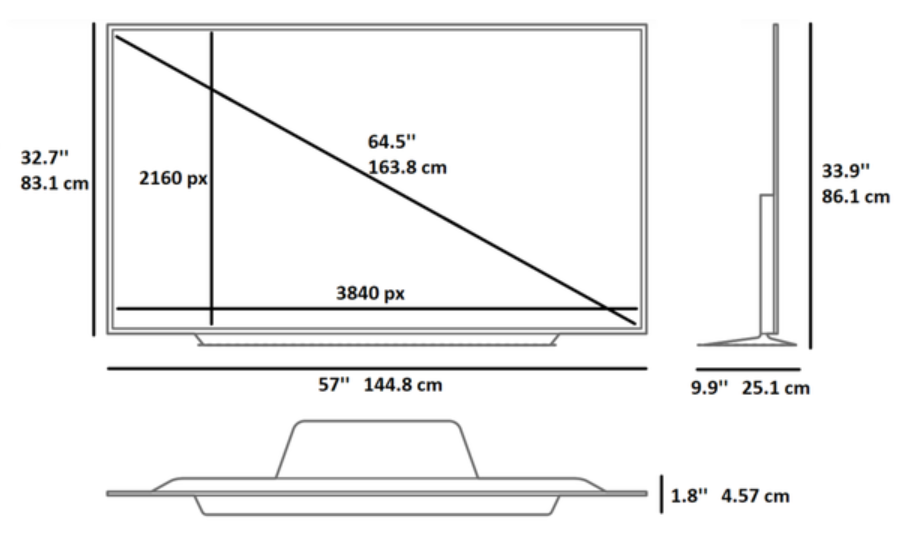How Wide is a 65 Inch TV?
With ever-increasing demand for larger TV screens to get more immersive viewing experiences, 65 inches has become one of the most popular choices for home entertainment setups. But in upgrading to this substantial size class, an important question arises – how wide is a standard 65 inch television? Below we’ll explore the various measurements and dimensions to expect with 65″ models across different brands. Whether you’re looking to upgrade your living room set or outfit a whole home theater, this guide will help you understand exactly what a 65″ set entails size-wise so you can plan your space perfectly.
Defining Screen Size Measurements
First, it’s helpful to understand what the listing for 65″ refers to specifically. The advertised size class denotes the diagonal screen dimension from corner to corner. This doesn’t directly correlate to width or height. Those aspects vary based on standard TV aspect ratios.
Common aspect ratios include:
- 16:9 – The most ubiquitous widescreen ratio used across most modern TV models. HD, 4K and 8K sets typically have 16:9 ratios.
- 21:9 – An even wider, cinematic scope ratio employed on higher-end widescreen TVs.
- 4:3– A standard ratio on older, non-widescreen sets. Few modern TVs use 4:3 but some retrotube-style models still exist.
With a 16:9 65″ TV for example, while the diagonal is 65″, the height is 36.3″ and the width is about 64.5″. However even sets within the same size class won’t be exactly identical in dimensions. Factors like bezel sizes, stand widths, and built-in speakers can create some variation among models.
The Width Range You Can Expect
Below is a table outlining the most common 65″ television widths you’ll see when shopping displays:
| Aspect Ratio | Exact Width | Width Range |
| 16:9 | 57.56″ | 56.5” – 58” |
| 21:9 | 73.8” | 72” – 75” |
As you can see, while a 16:9 ratio caps off around 58 inches, wider aspect ratio options like 21:9 can stretch over 73 inches! So if planning to fit your TV in a certain space, don’t assume all 65” options will fit that sizing.
Keep in mind that width doesn’t account for television depth or stand sizes either if not mounted. We’ll cover additional key measurements to factor in next.
Other Key Dimensions
Along with width, the height and depth should be measured to find units sized for your room constraints and viewing needs:
Television Depth
- Depth without wall mount: Ranges between 2.75” – 6” depending on model
- Depth with wall mount: Ranges between 4.75” (thinnest) and 6” from wall
Television Stand Width
- Varies greatly: 30” up to 60”+
- Consider width between legs – is there enough table space?
Don’t forget the TV’s weight as well for mounting considerations. Flat panel LED/OLED 65” sets weigh between 45 – 75 lbs typically. Bulkier older rear projection models hit 100+ lbs. Mounts should meet or exceed the VESA standard weight bearing capacity and display size requirements.
Ideal Setup Based on Viewing Distance
To achieve the optimal immersive experience from your new 65″ television, consider mounting or seating parameters and their effect on viewing angles and perceived screen size.
Recommended Distances Based on Screen Size
| Screen Size | Optimal Viewing Distance |
| 65 inches (16:9) | 7.5 – 10 feet |
| 65 inches (21:9) | 6 – 8 feet |
Viewing angle also comes into play. Aim for angles below 30 degrees off center for best picture quality and comfort. With swiveling wall mounts you can adjust left/right angles. The height level of eye line to middle of the screen should align as close to perpendicular as seating allows as well.
Also Read Other TV Size and Dimensions:
Summary
- The exact width for a 16:9 ratio 65″ TV caps off around 58 inches
- Factor in wider aspect ratio variations that can hit up to 75″
- Consider television depth, stands, optimal viewing distances and angles when planning your entertainment space.
With the dimensions and guidelines above for a typical 65 inch television, you have the details needed to pick the perfect model for your setting and viewing pleasure.
